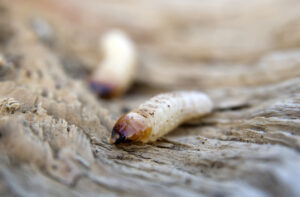
Need Help? Call Us On 0161 776 9832 For Expert Pest Control Advice On How To Identify Pest Infestations And Help Solve Your Pest Problem.
Professional St Helens Woodworm Treatment
Woodworm infestation: know the signs.
Have you noticed any of the following around your home?
 • Tiny round holes in wooden surfaces
• Tiny round holes in wooden surfaces
• Powdery wood dust below affected woodwork ("frass")
• Crumbling and weakened woodwork
• Tunnels ("galleries") inside damaged timber
• Tiny white grubs in affected woodwork
• Adult beetles
If so, your home may be at risk from severe damage by woodworm. Without prompt attention from professional pest control operatives, woodworm can ruin furniture, cause unsightly damage to woodwork, and can even weaken the timbers of your home. Don't leave St Helens woodworm treatment to chance — contact Young's Pest Control for expert help and advice.
Treatment for woodworm removal: why Do-it-Yourself won't do
 When it comes to St Helen's, woodworm treatment furniture is often the first thing that comes to mind. Indeed, it's not unknown for woodworm to be brought in with a vintage item that's been improperly cared for or stored. Unfortunately, this leads some householders to conclude that all they need to do is take the object out of the house, spray it with a "professional woodworm removal spray", and bring it back indoors once the treatment is concluded. Unfortunately, this could prove to be an expensive mistake.
When it comes to St Helen's, woodworm treatment furniture is often the first thing that comes to mind. Indeed, it's not unknown for woodworm to be brought in with a vintage item that's been improperly cared for or stored. Unfortunately, this leads some householders to conclude that all they need to do is take the object out of the house, spray it with a "professional woodworm removal spray", and bring it back indoors once the treatment is concluded. Unfortunately, this could prove to be an expensive mistake.
While a piece of furniture may well be the source of the infestation, it's not safe to assume that the woodworm will be confined to that one object. Infestations in floorboards or joists may be hidden away out of sight, while the surface of wooden furniture is usually more visible. Because of this, the signs of woodworm may be noticed on the table before they're recognised anywhere else, even if the infestation began in a different spot. Pest control professionals need to investigate any sign of woodworm, no matter how localised it might appear. If a woodworm infestation is left unchecked, it can cause severe damage.
Types of woodworm
The term "woodworm" is generally used for the Common Furniture Beetle (Anobium punctatum). However, the "worms" in question aren't worms — they're the maggot-like larvae of the beetle. While the Common Furniture Beetle is responsible for most infestations in the UK, some woodworm is caused by other species.
This is another reason to eschew that DIY woodworm treatment spray and get professional help. It's not easy for a layperson to distinguish between different types of beetle, and treatments that work effectively against one species may not work against another. The professional St Helens woodworm treatment furniture dealers apply to get rid of Anobium punctatum won't work if your infestation involves a different species. The House Longhorn Beetle and Death Watch Beetle, for example, require more extensive treatments than the Common Furniture Beetle — and can cause more aggressive damage.
Other problems
Where you find woodworm, you'll often find additional problems: other insect pests, fungal infestations and worse. A professional inspection can bring these to light, alerting you to early signs of damp, mould, and dry or wet rot.
If you suspect woodworm, contact Young's Pest Control. We offer effective professional treatment for woodworm and many other pests.
